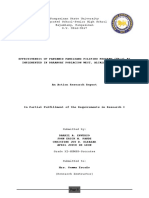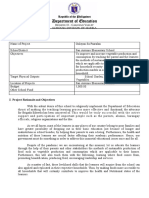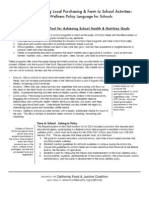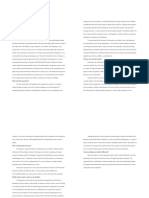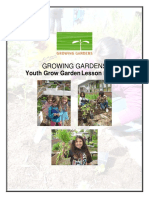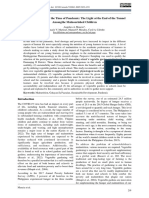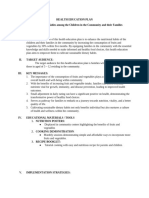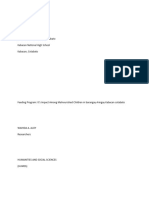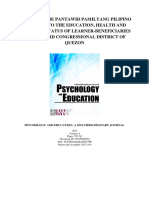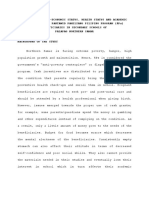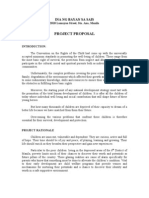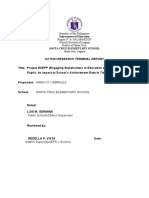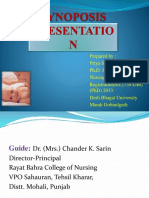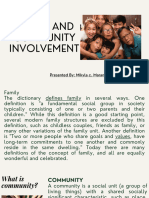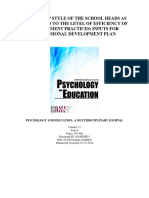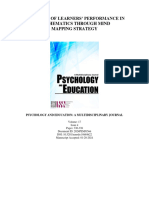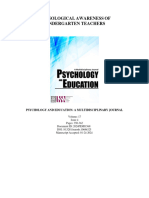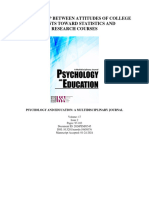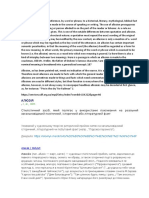Communal Gardening: Input For Socioeconomic Improvement of 4P's Family
Communal Gardening: Input For Socioeconomic Improvement of 4P's Family
Copyright:
Available Formats
Communal Gardening: Input For Socioeconomic Improvement of 4P's Family
Communal Gardening: Input For Socioeconomic Improvement of 4P's Family
Original Title
Copyright
Available Formats
Share this document
Did you find this document useful?
Is this content inappropriate?
Copyright:
Available Formats
Communal Gardening: Input For Socioeconomic Improvement of 4P's Family
Communal Gardening: Input For Socioeconomic Improvement of 4P's Family
Copyright:
Available Formats
COMMUNAL GARDENING: INPUT FOR
SOCIOECONOMIC IMPROVEMENT
OF 4P’S FAMILY
PSYCHOLOGY AND EDUCATION: A MULTIDISCIPLINARY JOURNAL
2023
Volume: 11
Pages: 743-747
Document ID: 2023PEMJ1006
DOI: 10.5281/zenodo.8216234
Manuscript Accepted: 2023-31-7
Psych Educ, 2023, 11: 743-747, Document ID:2023 PEMJ1006, doi:10.5281/zenodo.8216234, ISSN 2822-4353
Research Article
Communal Gardening: Input for Socioeconomic Improvement of 4P’s Family
Ma. Criselle Anne J. Baguio*, Ruby B. Brion
For affiliations and correspondence, see the last page.
Abstract
The purpose of studying communal gardening as an input for socioeconomic improvement of 4P's
family is to explore how this approach can help to address food insecurity, generate income, promote
social cohesion, and improve overall well-being among this vulnerable population. The investigation
covered the following: the Perceived Communal Gardening Related Variables as to Objectives,
Health and Nutrition, Hunger Eradication, Food Security, and Attitude. Contribution of Communal
Gardening for Socioeconomic Improvement as to Food, Health, Environment, Income and Family
Relationship. A total of 85 parents, who are beneficiaries of the 4P's program, were chosen from 10
distinct barangays within the school's catchment area. These parents actively took part in the survey
during the academic year 2022-2023. The results demonstrated a notable and positive association
between the socioeconomic advancement of 4P's families and communal gardening related variables.
In light of the findings, Even after the parents have graduated from the 4P's program as beneficiaries,
they can still engage in communal gardening within their own backyard, drawing on the knowledge
and skills acquired during their participation in the program. This activity can have significant
benefits for their family, and it can be passed down through generations to contribute to their
socioeconomic improvement. Despite the challenges of poverty, communal gardening can provide
valuable support to sustain their needs. In summary, parents can play an active role in communal
gardening, which can contribute to their daily lives by providing them with access to fresh produce,
new skills, social connections, educational opportunities, and even income-generating activities.
Keywords: 4p’s family, communal gardening, socioeconomic improvement
Introduction aims to improve the health and nutrition of each
household beneficiary. It ensures that they have access
to nutritious food by encouraging the cultivation of
The Philippines faces the issue of widespread poverty, vegetables and fruits in their own yards instead of
which is partly attributed to the extremely low relying solely on purchasing them. Additionally,
productivity within the agriculture sector. This beneficiaries have the option to sell their fresh
situation often drives people to migrate from rural produce, generating income for their families. Apart
areas to urban centers. Agriculture plays a vital role in from the nutritional and income-related benefits,
providing essential resources, particularly food, within backyard or communal gardening also contributes to
our country. However, the agricultural sector currently alleviating food shortages in the country. During the
stands as the most impoverished sector in the nation. Family Development Sessions (FDS), beneficiaries
To support the 4Ps program, the agriculture sector receive education on basic gardening techniques and
assists by distributing seeds, fertilizers, and technology other essential technologies that can enhance the
resources. Additionally, it encourages program growth of their harvests, enabling them to provide
beneficiaries to participate in various farming sufficient food for their families.
activities, such as communal gardening, backyard
gardening, backyard animal raising, and other income- The social advantages of gardening encompassed
generating endeavors. various aspects such as forming new connections,
In addition to fulfilling other program requirements establishing and nurturing friendships, and having a
such as sending their children to school, attending common interest that facilitates bonding with others.
monthly Family Development Sessions (FDS), Community gardening serves as an educational
providing pre and post-natal care for mothers, ensuring journey that aims to transform people's thinking and
regular check-ups for children aged 0 to 5 years, and behavior, enabling them to achieve economic and
deworming for children aged 0 to 14 years, social well-being through self-sufficiency. Gardening
beneficiaries of the 4Ps program are also expected to aligns with several initiatives of the Cooperative
maintain a backyard or communal garden. This Extension System, particularly the focus on enhancing
gardening aspect is a significant conditionality of the nutrition, diet, and health. This article elucidates the
program that beneficiaries must comply with. role of Extension in enhancing the quality of life and
socioeconomic well-being of individuals, families, and
By implementing this conditionality, the 4Ps program communities through the practice of community
Baguio & Brion 743/747
Psych Educ, 2023, 11: 743-747, Document ID:2023 PEMJ1006, doi:10.5281/zenodo.8216234, ISSN 2822-4353
Research Article
gardening.
Research Objectives Research Procedure
The objective of this study is to investigate the impact The title of this study was influenced by the
of communal gardening on the socioeconomic researcher's firsthand observations as a social science
development of families benefiting from the 4P's teacher working with families who are beneficiaries of
program. It aims to explore how communal gardening the 4P's program.The questionnaire related to the
influences their daily lives and the dynamics within Socioeconomic Improvement of 4P's Families through
their families, as well as their acquired knowledge in Communal Gardening. The subsequent step involves
gardening. creating a custom questionnaire consisting of three
parts underwent validation by four experts in the field,
including a Head Teacher and Master Teachers. The
Methodology researcher carefully considered the comments and
suggestions provided by the validators during the
Research design validation process.Prior to data collection, the
researcher obtained permission from the Office of the
A descriptive correlational designed was used in this School Principal to conduct the survey and administer
study in which in which the researcher is primarily the questionnaires to the intended respondents. After
interested in describing relationships among variables, receiving approval, the researcher proceeded to
without seeking to establish a causal connection. distribute the survey instruments to the parents using a
checklist. The data was then collected through the
Sampling and Ethical Consideration questionnaire.The parents were selected as participants
in this study because they play a crucial role in
Purposive sampling, alternatively referred to as practicing communal gardening for the betterment of
judgmental, selective, or subjective sampling, is a type their families as beneficiaries of the 4P's program. To
of non-probability sampling technique in which gather data, questionnaires were provided to the
researchers exercise their own discretion in selecting parents during the distribution of cards, and additional
individuals from the population to participate in their information was obtained through home visits. During
surveys.The respondents in this study consisted of 85 these visits, the researcher personally observed the
parents from 10 barangay of Calauag Quezon who are communal gardening activities as well as the backyard
beneficiaries of the 4P's program . The parents were gardens of the 4P's families. The study aimed to
selected as respondents using a purposive sampling explore how engaging in gardening can contribute to
technique, wherein the researcher deliberately chose the socioeconomic improvement of these families.
individuals based on specific criteria. This sampling
procedure ensured that each member of the population
Results and Discussion
had an equal opportunity to be included in the study.
Research Instruments Table 1. Summary table on the Communal Gardening
Related Variables
In order to gather information regarding the role of
communal gardening in the socioeconomic
improvement of 4P's families, the researcher employed
a self-made questionnaire. The questionnaire was
designed to collect responses and comments from the
respondents. The research instrument consist of three
parts. Part I is the demographic profile of the
respondents, Part II is the communal gardening related
variables. Part III is the Contribution of Communal
Gardening for Socioeconomic Improvement of 4p’s
Family. Part II and III Include likert scale of Highly
Manifested, Manifested, Slightly Manifested, and Not
Table 1 shows that the Communal Gardening Related
Manifested.
Variables received an overall average rating of 3.45.
Baguio & Brion 744/747
Psych Educ, 2023, 11: 743-747, Document ID:2023 PEMJ1006, doi:10.5281/zenodo.8216234, ISSN 2822-4353
Research Article
This indicates that, on average, respondents perceived improvement of 4Ps families.The average score
these variables positively in relation to some aspect of suggests that respondents generally acknowledged
communal gardening.Among the specific variables, communal gardening as beneficial for improving the
"Perceived Communal Gardening as to Food Security" socioeconomic conditions of 4Ps families.
received the highest mean rating of 3.50. This
indicates that the respondents viewed communal Perceived Contribution of Communal Gardening as to
gardening as having a positive impact on food Family Relationship with a Highest Score of 3.57:
security. This could imply that they believe communal This highest score suggests that respondents perceived
gardening helps provide a more secure and reliable communal gardening to have a significant and positive
source of food. impact on family relationships. It implies that
communal gardening activities may promote stronger
On the other hand, "Perceived Communal Gardening bonds, communication, and cooperation among family
as to Objectives" received the lowest mean rating of members. Also indicates that this aspect of communal
3.39. This show the respondents had a relatively lower gardening'scontribution to 4Ps families' lives is highly
perception of communal gardening's effectiveness in acknowledged and valued by the respondents.
achieving its objectives. This could imply that they
believe communal gardening may not be as successful Perceived Contribution of Communal Gardening as to
in meeting its intended goals or that there is room for Income with a Lowest Mean of 3.39 indicates that the
improvement in terms of achieving the objectives set respondents perceived communal gardening to have a
for communal gardening initiatives. relatively weaker impact on income generation. It
implies that the respondents might perceive communal
It's important to note that the specific contribution of gardening as less effective in directly improving the
communal gardening to the socioeconomic income levels of 4Ps families. However, it's important
improvement of 4Ps families can vary based on local to note that this lower mean score doesn't imply that
contexts, resources available, and the level of communal gardening has no impact on income but
community involvement. It's crucial to consider these rather indicates a relatively lower perception in
factors when designing and implementing communal comparison to other aspects.
gardening initiatives to maximize their impact on the
socioeconomic well-being of 4Ps families In summary, communal gardening has a significant
and positive contribution to the socioeconomic
Table 2. Summary table on the Contribution of improvement of 4Ps beneficiaries. It provides them
Communal Gardening for S o cioecono mic with access to nutritious food, enhances their skills and
Imp ro vement of 4p’s Family. employ-ability, fosters community engagement,
promotes environmental sustainability, and improves
mental well-being. By recognizing and supporting the
value of communal gardening, we can empower 4Ps
beneficiaries on their journey towards a better
socioeconomic future.
Table 3. Test of Correlation Between Communal
Gardening Objectives and Socioeconomic
Improvement
Overall Average of 3.47 for Contribution of
Communal Gardening for Socio econ om ic
Improvement of 4Ps Family indicates that the
respondents perceived communal gardening to have a
positive contribution to the socioeconomic
The computed correlation between Communal
Baguio & Brion 745/747
Psych Educ, 2023, 11: 743-747, Document ID:2023 PEMJ1006, doi:10.5281/zenodo.8216234, ISSN 2822-4353
Research Article
Gardening Objectives and Socioeconomic The correlation coefficient of r=0.629 indicates a
Improvement is shown in Table 13. The analysis result strong positive relationship between attitude towards
at 0.01 two-tailed level of significance revealed that communal gardening and using it to improve family
Socioeconomic Improvement has significant positive relationships as a means of socioeconomic
relationship with Communal Gardening Objectives. improvement. A p-value of ρ=0.01 suggests that this
relationship is statistically significant. Individuals who
The correlation coefficient of r=0.700 indicates a have a positive attitude towards communal gardening
strong positive relationship between attitude towards are more likely to use it as a means of improving their
communal gardening and using food as a means of family relationships and socioeconomic status.
socioeconomic improvement. A p-value of ρ=0.01 Overall, the findings suggest that a positive attitude
suggests that this relationship is statistically towards communal gardening has the potential to play
significant, meaning that it is unlikely to have occurred an important role in using it to improve family
by chance.This suggests that individuals who have a relationships as a means of socioeconomic
positive attitude towards communal gardening are improvement, and that this relationship is statistically
more likely to use food produced through this activity significant.
as a means of improving their socioeconomic status.
Communal gardening plays a crucial role in supporting
The correlation coefficient of r=0.636 indicates a the socioeconomic well-being of 4Ps beneficiaries. By
strong positive relationship between attitude towards engaging in communal gardening initiatives, these
communal gardening and using it to improve health as beneficiaries experience various positive impacts that
a means of socioeconomic improvement. A p-value of contribute to their overall improvement.
ρ=0.01 suggests that this relationship is statistically
significant, meaning that it is unlikely to have occurred
by chance. This suggests that individuals who have a
Conclusion
positive attitude towards communal gardening are
more likely to use it as a means of improving their Based on the study findings, it can be concluded that
health and socioeconomic status. This could include there is indeed a significant relationship between
using the physical activity involved in gardening as a communal gardening and socioeconomic improvement
means of improving fitness and reducing healthcare among the selected members of the 4P's program. As a
costs, or using the fresh produce grown in the garden result, the null hypothesis proposed in the study is
to improve nutrition and reduce healthcare costs. sustained or not supported.
The correlation coefficient of r=0.611 indicates a Based on the study's results and conclusions, the
strong positive relationship between attitude towards following recommendations are being proposed: first,
communal gardening and using it as a means of Conducting in-depth interviews or focus group
improving the en v ironm en t as a means of discussions with 4P's families engaged in communal
socioeconomic improvement. A p-value of ρ=0.01 gardening can provide deeper insights into their
suggests that this relationship is statistically experiences, challenges, and perceived benefits.
significant, meaning that it is unlikely to have occurred Second, Conduct a specific evaluation of the economic
by chance. This could include using communal outcomes of communal gardening for 4P's families.
gardening to reduce food miles and carbon footprint by This can include analyzing income generation, cost
growing food locally, or using organic gardening savings from homegrown produce, access to local
methods to reduce the use of harmful chemicals in the markets, and the potential for entrepreneurship or
environment. value-added activities. Third, Identify specific areas
where 4P's families may need additional support or
The correlation coefficient of r=0.578 indicates a interventions to maximize the benefits of communal
moderate positive relationship between sustainable gardening. This could include providing training
development in communal gardening and using it to programs and connecting them with relevant
improve income as a means of socioeconomic government or non-governmental organizations for
improvement. A p-value of ρ=0.01 suggests that this additional assistance. Fourth, Encourage collaboration
relationship is statistically significant, meaning that it and knowledge-sharing among different stakeholders
is unlikely to have occurred by chance. This could involved in communal gardening initiatives, including
include using sustainable gardening practices to reduce go vern men t agencies, NGOs, community
costs and increase yields, or selling excess produce to organizations, and researchers. Facilitating platforms
generate additional income. for exchange, learning, and networking can enhance
Baguio & Brion 746/747
Psych Educ, 2023, 11: 743-747, Document ID:2023 PEMJ1006, doi:10.5281/zenodo.8216234, ISSN 2822-4353
Research Article
the collective understanding of communal gardening's Koay et al., (2020) Community Gardening: Stress, Well-Being, and
Resilience Potentials - PMC (nih.gov)
potential and contribute to the development of best
practices and effective strategies for supporting 4P's Inocian, R. B., & Nuneza, L. M., (2015). THE “GULAYAN SA
families. PAARALAN” (SCHOOL VEGETABLE GARDEN) IN
RESPONSE TO SUSTAINABLE DEVELOPMENT. European
Scientific Journal vol.11, No.8 ISSN: 1857 – 7881 (Print) e - ISSN
References 1857- 7431.
S. Dilip and Allan Thomas (2017) Constraints Perceived by Students
Alaimo, Katherine PhD 1, Elizabeth Packnett MPH, Richard A. in School Vegetable Gardening, Journal of Extension Education
Miles BS and Daniel J. Kruger PhD,March-April 2008, Fruit and Vol. 29 No. 1, 2017 Pantawid Pamilyang Pilipino Program (4Ps) |
Vegetable Intake among Urban Community Gardeners, Journal of DSWD Field Office CAR Official Website
Nutrition Education and Behavior, Volume 40, Issue 2, Pages 94-
101 Siewell et al., Building Sustainable Neighborhoods through
Community Gardens: Enhancing Residents’ Well-being through
Christine M. Porter(2018)What gardens grow: Outcomes from home University Community Engagement Initiative. EJ1092961.pdf
and community gardens supported by community-based food justice (ed.gov)
organizations
Eunice L. Lluz (2022), Economic Impact Of Pantawid Affiliations and Corresponding Information
PamilyangPilipino Program (4ps) Implementation On The
Agricultural Protection In Selected Towns In Northern Samar, Ma. Criselle Anne J. Baguio
Philippines. Journal of Positive School Laguna State Polythecnic University - Philippines
Psychologyhttp://journalppw.com 2022, Vol. 6, No. 8, 10470-10480
Ruby B. Brion, PhD
Mary L. Ohmer(2009) Community Gardening and Community Laguna State Polythecnic University - Philippines
Development: Individual, Social and Community Benefits of a
Community Conservation Program.
Mdiya & Mdoda (2021), Socioeconomic factors affecting home
gardens as a livelihood strategy in rural areas of the Eastern Cape
province, South Africa Vol. 49 No. 3, 2021:1-15
Baguio & Brion 747/747
You might also like
- Effectiveness of Pantawid Pamilyang PiliDocument17 pagesEffectiveness of Pantawid Pamilyang PiliDell Asus94% (51)
- Gulayan Sa Paaralan Proposal 2020-2021Document9 pagesGulayan Sa Paaralan Proposal 2020-2021Jose Paguyo100% (1)
- Error Identification ExerciseDocument1 pageError Identification Exerciseenesus75% (4)
- Costume DramaDocument3 pagesCostume DramaAlexandra Kohut-Cole100% (1)
- Theories of Punishment PDFDocument15 pagesTheories of Punishment PDFjyoti singh100% (1)
- Model School Wellness Policy Language For Making Farm To SchoolDocument4 pagesModel School Wellness Policy Language For Making Farm To SchoolCalifornia Food and Justice CoalitionNo ratings yet
- Assignment 2 TemplateDocument16 pagesAssignment 2 TemplateratrisanjumanNo ratings yet
- Community Engaged Learning Project Collaboration With Wellington-Dufferin-Guelph Public HealthDocument9 pagesCommunity Engaged Learning Project Collaboration With Wellington-Dufferin-Guelph Public Healthapi-300330301No ratings yet
- Nutrition Education and Fresh Produce GrantDocument23 pagesNutrition Education and Fresh Produce Grantapi-582282306No ratings yet
- Parents Perceptionin School Based Feeding Program 358Document18 pagesParents Perceptionin School Based Feeding Program 358Charwayne DaitNo ratings yet
- Parents Perceptionin School Based Feeding ProgramDocument18 pagesParents Perceptionin School Based Feeding ProgramAiza ConchadaNo ratings yet
- Intervention AssignmentDocument11 pagesIntervention Assignmentapi-650024037No ratings yet
- Group 3-NSTP-CA-Final-Project-ProposalDocument11 pagesGroup 3-NSTP-CA-Final-Project-Proposalshaynework16No ratings yet
- Gulayan Sa Paaralan at Tahanan ProposalDocument6 pagesGulayan Sa Paaralan at Tahanan ProposalWendy Dalere BalisacanNo ratings yet
- The Indoor Vertical Farm Is OperationalDocument11 pagesThe Indoor Vertical Farm Is OperationalARPRaguRamanNo ratings yet
- Inbound 3477600983323268803Document39 pagesInbound 3477600983323268803JoyNo ratings yet
- Research Proposal Number 0221628Document8 pagesResearch Proposal Number 0221628IsaAparicioNo ratings yet
- Nutrition ResearchDocument8 pagesNutrition ResearchGwendareign ElizanNo ratings yet
- Health Education Plan 2.0Document8 pagesHealth Education Plan 2.0Dianna AsugNo ratings yet
- SBFP Best Practices & Narrative ReportDocument3 pagesSBFP Best Practices & Narrative ReportNemfa Gaco Tumacder100% (17)
- A New Deal for School GardensFrom EverandA New Deal for School GardensNo ratings yet
- Nutritional Status To Academic PerformanceDocument18 pagesNutritional Status To Academic Performanceabdullahmuizza65No ratings yet
- Project Proposal Format 2023Document11 pagesProject Proposal Format 2023vanessa.balmesNo ratings yet
- Sprin Internship - Project - Hannah AllenDocument2 pagesSprin Internship - Project - Hannah Allenapi-666106045No ratings yet
- Youth Grow Garden Lesson Manual - Jan 2016Document91 pagesYouth Grow Garden Lesson Manual - Jan 2016Broșu ConstantinNo ratings yet
- Cultivating Learning With School GardensDocument210 pagesCultivating Learning With School Gardensz7qdNo ratings yet
- The Roles of Teachers' Knowledge and Implementation of School-Based Feeding Program On Pupils' Academic PerformanceDocument9 pagesThe Roles of Teachers' Knowledge and Implementation of School-Based Feeding Program On Pupils' Academic PerformanceJournal of Interdisciplinary PerspectivesNo ratings yet
- Project-Proposal ExampleDocument6 pagesProject-Proposal Examplecristopher101618No ratings yet
- Food Preparation Practices and Nutrition Knowledge of Household Caregivers in Southern Kwazulu NatalDocument20 pagesFood Preparation Practices and Nutrition Knowledge of Household Caregivers in Southern Kwazulu NatalRitu B MalhotraNo ratings yet
- Bped 14 Module 2 1Document10 pagesBped 14 Module 2 1tintin111499No ratings yet
- THESISDocument28 pagesTHESISMilbert Loyloy SalmasanNo ratings yet
- Assignment of Social and Preventive PharmacyDocument45 pagesAssignment of Social and Preventive Pharmacydeekshapatel.7665No ratings yet
- Vegetable Garden in The Time of Pandemic: The Light at The End of The Tunnel Among The Malnourished ChildrenDocument8 pagesVegetable Garden in The Time of Pandemic: The Light at The End of The Tunnel Among The Malnourished ChildrenPsychology and Education: A Multidisciplinary JournalNo ratings yet
- 4 P'sDocument10 pages4 P'sMARY GRACE OLFINDO0% (1)
- CgshsDocument14 pagesCgshsMaricel CariagaNo ratings yet
- Intro About Yourself and Acknowledging The Deped and BerfDocument38 pagesIntro About Yourself and Acknowledging The Deped and BerfJung HoseokNo ratings yet
- School Gardening Best PracticesDocument25 pagesSchool Gardening Best PracticesU8x58No ratings yet
- Chapter 1-3 VigilDocument31 pagesChapter 1-3 Vigiljhedrickvrylleavigil10No ratings yet
- Health Education PlanDocument5 pagesHealth Education PlanDianna AsugNo ratings yet
- Farming Project For StudentsDocument5 pagesFarming Project For StudentsMYRAH GRACIELA TUTONGNo ratings yet
- Gov Liezl Victoria F. PanisDocument21 pagesGov Liezl Victoria F. PanisAiza ConchadaNo ratings yet
- Peer Education Is A Feasible Method of Disseminating Information Related To Child Nutrition and Feeding Between New MothersDocument8 pagesPeer Education Is A Feasible Method of Disseminating Information Related To Child Nutrition and Feeding Between New MothersKomala SariNo ratings yet
- Creating and Growing Edible SchoolyardsDocument36 pagesCreating and Growing Edible SchoolyardsU8x58100% (1)
- Republic of The PhilippinesDocument9 pagesRepublic of The PhilippinesHaGuiar A. AsiNo ratings yet
- Agri - II - Sem - Introduction To Agriculture ExtensionDocument6 pagesAgri - II - Sem - Introduction To Agriculture ExtensionSteve MsiskaNo ratings yet
- Bugs Common Grant AppDocument24 pagesBugs Common Grant Appapi-258308283No ratings yet
- Lesson Plans Food and NutritionDocument17 pagesLesson Plans Food and NutritionОксана ТеплаNo ratings yet
- WEE THC 10 Feb 28 March 2 ActivityDocument7 pagesWEE THC 10 Feb 28 March 2 ActivityNicholas Xavier VenturaNo ratings yet
- Impact of The Pantawid Pamilyang Pilipino Program To The Education, Health and Nutrition Status of Learner-Beneficiaries in The Third Congressional District of QuezonDocument14 pagesImpact of The Pantawid Pamilyang Pilipino Program To The Education, Health and Nutrition Status of Learner-Beneficiaries in The Third Congressional District of QuezonPsychology and Education: A Multidisciplinary JournalNo ratings yet
- Thesis ProposalDocument55 pagesThesis ProposalSheryl Tubino EstacioNo ratings yet
- Pantawid Pamilyang Pilipino Program (4Ps) Beneficiaries in Selected Schools in The Division of PalawanDocument12 pagesPantawid Pamilyang Pilipino Program (4Ps) Beneficiaries in Selected Schools in The Division of PalawanPsychology and Education: A Multidisciplinary Journal100% (1)
- Community Organizing NCM 113: Colegio San Agustin - Bacolod College of Health and Allied ProfessionsDocument6 pagesCommunity Organizing NCM 113: Colegio San Agustin - Bacolod College of Health and Allied Professionsczeremar chanNo ratings yet
- Cream Green Light Simple Presentation_20240311_194643_0000 (1)Document25 pagesCream Green Light Simple Presentation_20240311_194643_0000 (1)mikylamarananNo ratings yet
- Project Proposal: Ina NG Bayan Sa SaisDocument4 pagesProject Proposal: Ina NG Bayan Sa SaisRence Karlo IletoNo ratings yet
- Health Education Programme by School Children in The SchoolDocument26 pagesHealth Education Programme by School Children in The SchoolALCAIDE, REYMAR C.No ratings yet
- Ijerph 19 14415Document22 pagesIjerph 19 14415Yumaizar FitriaNo ratings yet
- AR - Proposal Project ESEPPDocument11 pagesAR - Proposal Project ESEPPLILY MAY GONZALESNo ratings yet
- M.sc. Nursing SyllabusDocument35 pagesM.sc. Nursing SyllabusPriya SharmaNo ratings yet
- Cream Green Light Simple PresentationDocument18 pagesCream Green Light Simple PresentationmikylamarananNo ratings yet
- Completions Report For Every Project Innovations Igp VeggiesDocument5 pagesCompletions Report For Every Project Innovations Igp VeggiesHardy MisagalNo ratings yet
- 2020 NutritionqualitativestudyDocument9 pages2020 Nutritionqualitativestudyrahayu dewiNo ratings yet
- Current Research in Nutrition and Food ScienceDocument8 pagesCurrent Research in Nutrition and Food Sciencenewbire vlogNo ratings yet
- Psychology and Education: A Multidisciplinary JournalDocument11 pagesPsychology and Education: A Multidisciplinary JournalPsychology and Education: A Multidisciplinary JournalNo ratings yet
- Post-Pandemic Performance in Content Mastery and Cognitive Skills of Junior High School Students in ChemistryDocument7 pagesPost-Pandemic Performance in Content Mastery and Cognitive Skills of Junior High School Students in ChemistryPsychology and Education: A Multidisciplinary JournalNo ratings yet
- Unlocking Opportunities: The Key To Successful Destigmatization of Ex-OffendersDocument11 pagesUnlocking Opportunities: The Key To Successful Destigmatization of Ex-OffendersPsychology and Education: A Multidisciplinary JournalNo ratings yet
- Improving Mastery Level in Understanding Typhoon and Earthquake Preparedness Through STEM ModulesDocument12 pagesImproving Mastery Level in Understanding Typhoon and Earthquake Preparedness Through STEM ModulesPsychology and Education: A Multidisciplinary JournalNo ratings yet
- Leadership Style of The School Heads As Correlates To The Level of Efficiency of Management Practices: Inputs For Professional Development PlanDocument15 pagesLeadership Style of The School Heads As Correlates To The Level of Efficiency of Management Practices: Inputs For Professional Development PlanPsychology and Education: A Multidisciplinary JournalNo ratings yet
- The Level of Learners' Performance in Mathematics Through Mind Mapping StrategyDocument9 pagesThe Level of Learners' Performance in Mathematics Through Mind Mapping StrategyPsychology and Education: A Multidisciplinary JournalNo ratings yet
- Phonological Awareness of Kindergarten TeachersDocument14 pagesPhonological Awareness of Kindergarten TeachersPsychology and Education: A Multidisciplinary Journal100% (1)
- Influence of Teacher's Personality and Behavior On Students Character BuildingDocument8 pagesInfluence of Teacher's Personality and Behavior On Students Character BuildingPsychology and Education: A Multidisciplinary JournalNo ratings yet
- Self-Concept and Level of Career Interest of Grade 9 Students at San Roque National High SchoolDocument10 pagesSelf-Concept and Level of Career Interest of Grade 9 Students at San Roque National High SchoolPsychology and Education: A Multidisciplinary JournalNo ratings yet
- Exploring Factors Influencing The Non-Completion of Theses Among Teachers Pursuing A Master's Degree: A Case Study AnalysisDocument10 pagesExploring Factors Influencing The Non-Completion of Theses Among Teachers Pursuing A Master's Degree: A Case Study AnalysisPsychology and Education: A Multidisciplinary JournalNo ratings yet
- Pet Loss: A Study On The Relationship Between Attachment Styles and Cognitive-Emotion Regulation Strategy Among Elderly Pet Owners in Quezon CityDocument12 pagesPet Loss: A Study On The Relationship Between Attachment Styles and Cognitive-Emotion Regulation Strategy Among Elderly Pet Owners in Quezon CityPsychology and Education: A Multidisciplinary JournalNo ratings yet
- Empowerment, Organizational Commitment, and Management Performance of Secondary School Heads in The New Normal in The Division of PalawanDocument16 pagesEmpowerment, Organizational Commitment, and Management Performance of Secondary School Heads in The New Normal in The Division of PalawanPsychology and Education: A Multidisciplinary JournalNo ratings yet
- Four Dimensions of Personnel Relational Work in Multi-Settings: Deriving Sociograms For Work Dynamism and DynamicsDocument17 pagesFour Dimensions of Personnel Relational Work in Multi-Settings: Deriving Sociograms For Work Dynamism and DynamicsPsychology and Education: A Multidisciplinary JournalNo ratings yet
- Game-Based and Project-Based Approaches: Their Effects On Grade 10 Learners' Performance in BiologyDocument9 pagesGame-Based and Project-Based Approaches: Their Effects On Grade 10 Learners' Performance in BiologyPsychology and Education: A Multidisciplinary JournalNo ratings yet
- Digital Orientation and Cyber-Victimization of College Students As Mediated by Their Attitude Toward CrimeDocument12 pagesDigital Orientation and Cyber-Victimization of College Students As Mediated by Their Attitude Toward CrimePsychology and Education: A Multidisciplinary JournalNo ratings yet
- The Experiences of The Lebakeño Grade XI Students On Learning Mathematics in The Modular Approach: Basis For Learning FrameworkDocument34 pagesThe Experiences of The Lebakeño Grade XI Students On Learning Mathematics in The Modular Approach: Basis For Learning FrameworkPsychology and Education: A Multidisciplinary JournalNo ratings yet
- SQP2RS Strategy in Teaching Reading Using Different Text Types Among Grade 9 Learners: An Experimental InquiryDocument13 pagesSQP2RS Strategy in Teaching Reading Using Different Text Types Among Grade 9 Learners: An Experimental InquiryPsychology and Education: A Multidisciplinary JournalNo ratings yet
- Multimedia Approach in Teaching Science Grade 7Document10 pagesMultimedia Approach in Teaching Science Grade 7Psychology and Education: A Multidisciplinary JournalNo ratings yet
- The Influence of Digital Marketing Strategies On Customer's Purchase Intention of Selected Fast-Food RestaurantsDocument14 pagesThe Influence of Digital Marketing Strategies On Customer's Purchase Intention of Selected Fast-Food RestaurantsPsychology and Education: A Multidisciplinary JournalNo ratings yet
- Grade 11 ICT Students' Mastery Level in Setting Up Computer Networks Instructed Using CSS DroidDocument5 pagesGrade 11 ICT Students' Mastery Level in Setting Up Computer Networks Instructed Using CSS DroidPsychology and Education: A Multidisciplinary JournalNo ratings yet
- Effectiveness of Gamification Strategy in Increasing The Grade 10 Student's Academic MotivationDocument9 pagesEffectiveness of Gamification Strategy in Increasing The Grade 10 Student's Academic MotivationPsychology and Education: A Multidisciplinary JournalNo ratings yet
- Love Corner: Enhancing Students' English VocabularyDocument10 pagesLove Corner: Enhancing Students' English VocabularyPsychology and Education: A Multidisciplinary JournalNo ratings yet
- Watching Movies With English Subtitles and Vocabulary Performance of SPA LearnersDocument12 pagesWatching Movies With English Subtitles and Vocabulary Performance of SPA LearnersPsychology and Education: A Multidisciplinary JournalNo ratings yet
- Classroom Management Practices of Teachers and Academic Performance of Grade 3 Learners Across All Learning AreasDocument10 pagesClassroom Management Practices of Teachers and Academic Performance of Grade 3 Learners Across All Learning AreasPsychology and Education: A Multidisciplinary JournalNo ratings yet
- Vocabulary Development and Comprehension Skills Through Word Games Among Grade 4 LearnersDocument11 pagesVocabulary Development and Comprehension Skills Through Word Games Among Grade 4 LearnersPsychology and Education: A Multidisciplinary JournalNo ratings yet
- Relationship Between Attitudes of College Students Toward Statistics and Research CoursesDocument8 pagesRelationship Between Attitudes of College Students Toward Statistics and Research CoursesPsychology and Education: A Multidisciplinary JournalNo ratings yet
- Information and Communication Technology (ICT) Skills Among Teachers in The Division of Lanao Del NorteDocument14 pagesInformation and Communication Technology (ICT) Skills Among Teachers in The Division of Lanao Del NortePsychology and Education: A Multidisciplinary JournalNo ratings yet
- Career Pathways of Technical, Vocational and Livelihood Senior High School Graduates in Pililla National High SchoolDocument10 pagesCareer Pathways of Technical, Vocational and Livelihood Senior High School Graduates in Pililla National High SchoolPsychology and Education: A Multidisciplinary Journal100% (1)
- Effect of T Math Modules To The Numeracy Level of Grade 6 Learners of Patabog Elementary SchoolDocument12 pagesEffect of T Math Modules To The Numeracy Level of Grade 6 Learners of Patabog Elementary SchoolPsychology and Education: A Multidisciplinary JournalNo ratings yet
- Impact of Mental Health Literacy On Attitude Toward Seeking Counseling Among Senior High School Students of Dr. Carlos S. Lanting CollegeDocument9 pagesImpact of Mental Health Literacy On Attitude Toward Seeking Counseling Among Senior High School Students of Dr. Carlos S. Lanting CollegePsychology and Education: A Multidisciplinary JournalNo ratings yet
- The Relationship Between Physical Activity, Body Mass Index and Body Composition Among Students at A Pre-University Centre in MalaysiaDocument8 pagesThe Relationship Between Physical Activity, Body Mass Index and Body Composition Among Students at A Pre-University Centre in MalaysiaNUR SABILA BT MOHAMAD MoeNo ratings yet
- Practice Occupational Health and Safety ProceduresDocument4 pagesPractice Occupational Health and Safety ProceduresREYNALDO DONIONo ratings yet
- Atlantic Computers Group XIIDocument13 pagesAtlantic Computers Group XIIsumit indianNo ratings yet
- After The Storm FinalDocument106 pagesAfter The Storm FinalNye Lavalle100% (1)
- Millions of Footprints - FloritaDocument2 pagesMillions of Footprints - Floritalorraine galvezNo ratings yet
- Concept Sa Et EmpowermentDocument3 pagesConcept Sa Et EmpowermentRoens ArdemilNo ratings yet
- How To Draw An Angel PDFDocument9 pagesHow To Draw An Angel PDFandhi hermawanNo ratings yet
- Padmini 10XQCMA067 AdityaBirlaFinance Internship ReportDocument72 pagesPadmini 10XQCMA067 AdityaBirlaFinance Internship ReportPadmini ManthriNo ratings yet
- Posey v4Document10 pagesPosey v4Steve TompkinsNo ratings yet
- G.R. No. L-17819 A. Federation of United Namarco Distributors vs. Namarco, 4 SCRA 867 - Loss of Thing DueDocument10 pagesG.R. No. L-17819 A. Federation of United Namarco Distributors vs. Namarco, 4 SCRA 867 - Loss of Thing DueLeslie Joy MingoNo ratings yet
- School Grade Level/Sectio N Teacher Learning Area Teaching Date and Time Quarter Grade 11 Daily Lesson PlanDocument6 pagesSchool Grade Level/Sectio N Teacher Learning Area Teaching Date and Time Quarter Grade 11 Daily Lesson PlanKrystel Grace Calderon-BunielNo ratings yet
- Primer Milk ProteinDocument12 pagesPrimer Milk ProteinAmos MainaNo ratings yet
- Differentiation of The Word Between Individual and Dual Sports and The Common and Most Popular Individual and Dual SportsDocument6 pagesDifferentiation of The Word Between Individual and Dual Sports and The Common and Most Popular Individual and Dual SportsSTEPHANY LAGUMBAYNo ratings yet
- Tour Guide TurkeyDocument16 pagesTour Guide TurkeyNick Imran100% (1)
- Hair Tutorials - 30 Days of Twist & PinDocument77 pagesHair Tutorials - 30 Days of Twist & Pinrvf1100% (3)
- ALMIRA ResumeDocument3 pagesALMIRA ResumeJobelle Marquez AlmiraNo ratings yet
- Алюзія - Onlyart: Алюзія (Лат. Allusio - Жарт, Натяк) - Художньо-Стилістичний Прийом, Натяк, Відсилання ДоDocument6 pagesАлюзія - Onlyart: Алюзія (Лат. Allusio - Жарт, Натяк) - Художньо-Стилістичний Прийом, Натяк, Відсилання ДоОльга ГерасимчукNo ratings yet
- Meteors (Group 10)Document32 pagesMeteors (Group 10)ValerieNo ratings yet
- UntitledDocument53 pagesUntitledArnab Manna100% (1)
- Olmec Ancestry Study (Small Article)Document5 pagesOlmec Ancestry Study (Small Article)illumin7No ratings yet
- Personalities in Institutional Corrections and Their Significant ContributionsDocument2 pagesPersonalities in Institutional Corrections and Their Significant ContributionsAngelica RacalNo ratings yet
- HR KPIsDocument151 pagesHR KPIstaapNo ratings yet
- The Cynefin Review: Simon PowersDocument37 pagesThe Cynefin Review: Simon PowersIonut Grecu100% (2)
- Glan Institute of Technology Glan, Sarangani 2 Semester SY 2022-2023Document4 pagesGlan Institute of Technology Glan, Sarangani 2 Semester SY 2022-2023Shaina Jandoc TalanginNo ratings yet
- Foreigners ActDocument6 pagesForeigners ActDebarchanaNo ratings yet
- JSA-G3 'Portable Fire Extinguisher Usage'Document2 pagesJSA-G3 'Portable Fire Extinguisher Usage'nathan schaalNo ratings yet
- Rescue 1122 - WikipediaDocument11 pagesRescue 1122 - WikipediaIshfaq AhmadNo ratings yet
